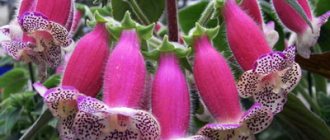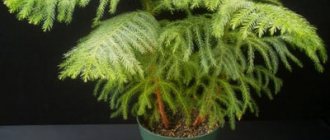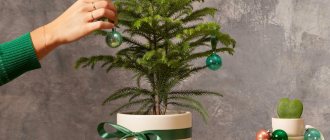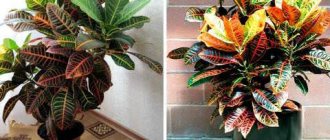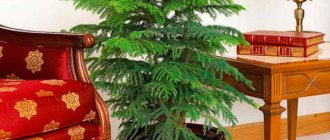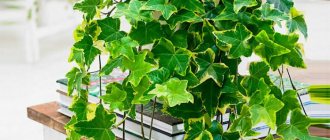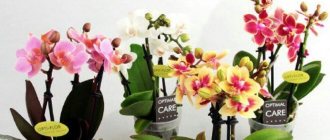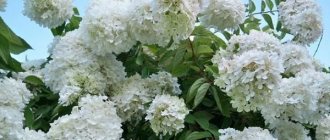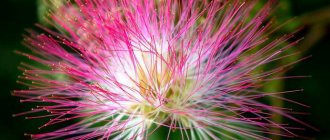Among the rare indoor plants you can see a beautiful Christmas tree, reminiscent of the joyful New Year. But the plant was not bought at the Christmas tree market. Relict Araucaria, grown on our own, decorates our home all year round.
Growing Araucaria in ordinary city apartments is not entirely easy . In order for an unusual “reverse Christmas tree” to please its owners for a long time with its appearance and fill the room with a special aroma, it is necessary to follow the recommended care rules.
And then the branches, directed upward, and not downwards, like those of ordinary Christmas trees, covered with evergreen needles, will be able to recall the distant Jurassic period of the Mesozoic era, when Araucaria reigned in a warm climate . What is this magical tree of antiquity?
Indoor types of araucaria
Araucaria has several indoor species suitable for successful cultivation in an apartment.
| View | Description |
| Brazilian (Narrow-leaved) | The trunk is up to 60 cm, the branches grow straight. The needles are generously distributed among the branches, soft. The crown is quite lush. Cleans the air perfectly. The price is about 1500 rubles. |
| Columnar | A very tall tree, up to 50 m. The leaves are bright green, located on hanging branches, up to 5 cm long. |
| Araucaria Varifolia (Norfolk, Heterophyll) | A very tall tree, up to 70 m. Pyramidal and narrow crown. The branches are very short. |
| Araucaria Chilean | Height up to 60 m, girth about 2 m. The branches are tightly pressed to each other with very hard leaves-needles of a dark green color. The crown is broadly pyramidal. |
| Araucaria Bidwillam (Bunia) | Wide-pyromidal shape and horizontally located branches. The needles are dark green, the cones are quite large. The plant is not a beautiful species, but it is very unpretentious, so it grows successfully in Russia. |
Araucaria is often used in bonsai compositions. The plant takes a long time to form and reduce in size over decades, resulting in a tree 30 cm high.
taxonomy
Araucaria angustifolia
was described by (Bertol.) Kuntze and published in
Revisio Generum Plantarum
3(3): 375. 1898. [3]
Etymology
of Araucaria
: a general geographical name alluding to its location in Arauco.
angustifolia
: Latin epithet meaning "with narrow leaves."
[ 4 ] Synonyms
- Araucaria brasiliensis
A.Rich. - Araucaria brasiliensis var.
gracilis Career - Araucaria brasiliensis var.
ridolfiana (P.Savi) Gordon - Araucaria brasiliensis var.
saviana (Parl.) Parl. - Araucaria brasiliensis
Loudon - Araucaria brasiliensis
A. Rich. - Araucaria brasiliensis var.
saviana (Parl.) Parl. - Araucaria dioecious
(Vell.) Stellfeld - Araucaria elegant
Quarry - Araucaria ridolfiana
Pi.Savi - Araucaria saviana
Parl. - Columbia angustifolia
Bertol. - Columbea brasiliana
(A.Rich.) Career - Columbea brasiliana var.
Elegance Career - Columbea brasiliana var.
ridolfiana (Pi.Savi) Career - Columbea brasiliensis var.
Ridolfina (P. Savi) Career - Pine dioecious
Well. [ 5 ] [ ]
Home care
Araucaria is native to southern countries and hot, very humid climates, but this does not mean that tropical conditions will have to be created indoors. When caring for her at home, you need to take into account that she loves spacious rooms and fresh air.
Araucaria prefers a temperate climate, the light should be diffused and the air should be cool and humid. Very young spruce trees are grown in the apartment; they do not tolerate bright light; in nature they grow in the shade. Indoor species do not bloom, only cones are formed.
| Season/Option | Lighting/Location | Temperature | Humidity |
| Spring | Place in a place with diffused but bright light. Shade on the south side. | Should be cool around +20°C. | High, more than 60%. Regularly spray or pour expanded clay into the pot and constantly moisten it. |
| Summer | Suitable for growing on a loggia. Place in partial shade or a place with diffused light. If possible, take it out into the garden. | Can't stand the heat. Optimal – from +21°C to +25°C. | Spray regularly. |
| Autumn | Partial shade or diffused light. On the north side, regularly turn the plant in different directions so that it does not develop one-sidedly. | Moderate – +20°C. | Keep it high, as dry air is destructive. Spray twice a day. |
| Winter | Bright and diffused light, or partial shade. | Protect from drafts. Not lower than +15°C. | High, frequent spraying required. Place away from the battery. Spray in the morning and evening. |
| Season/Option | Watering | Top dressing |
| Spring | As the soil dries out. If the soil is wet, simply spray the plant with water. | Once every three weeks with special mixtures for coniferous species. |
| Summer | You cannot flood the plant, but it is important to keep the soil moist; you can sprinkle expanded clay on top and constantly moisten it. | Mineral fertilizers once every 3 weeks. |
| Autumn | As the soil dries out. | Need not. |
| Winter | Reduce. |
Choosing a pot, soil, replanting
A large and roomy pot is definitely needed, preferably ceramic. It should have drain holes. Drainage is required to prevent the root system from rotting.
The soil should be fertile and loose, conducting air and nutrients. You can buy a ready-made earthen mixture or make it yourself.
The peculiarity of araucaria is that it does not tolerate transplants. Young Christmas trees grow well in one pot for up to 6 years; adult plants need to be replanted once every 4 years. Planting is carried out at the end of spring.
Step by step procedure:
- Pour drainage and soil into the pot.
- Remove the plant and plant it with a lump of earth in a new pot and sprinkle with soil.
- The roots must not be touched or disturbed, otherwise the spruce will die.
Plant pruning and bonsai formation
Indoor species do not need pruning. In mature spruce trees, you can trim off the bare lower branches. To avoid diseases and infections, the plant must be treated with sulfur.
The formation of bonsai occurs as follows:
- To make an interesting composition in the spring, the crown of the araucaria is adjusted. Cut off excess branches that do not hold the desired shape.
- In May, young shoots of the plant are pinched or pinched to shorten them.
- Using simple wire, the trunk and branches are shaped. It can be left for 3-4 months, then removed.
Reproduction
Araucaria propagation occurs in two ways:
- Seeds. Houses are sown in soil with peat and humus. The earth is watered and placed in a warm place. The first shoots will appear in a few months.
- By cuttings. The top shoots from a large tree are suitable for cuttings. Planted in spring. The cuttings are dried and treated with root. Then they are planted in soil with peat and sand, warming the soil. Each cutting needs its own container, all of them are covered with film. They take root in about 2 months, then they can be transplanted into a permanent pot.
Priming
Araucaria needs a breathable and loose substrate. A nutritious, slightly acidic (pH 5.3 – 6.2) soil is suitable for it. You can make the soil mixture yourself by taking 1 part turf soil, 2 parts perlite, peat soil and leaf soil. You can buy ready-made soil for conifers or a universal substrate for indoor plants and mix it with the substrate for azaleas and rhododendron. Be sure to add crushed pine needles, coal powder, chopped sphagnum, foam balls or brick chips to the soil mixture.
Errors in care and their elimination
| Errors | Causes | Elimination |
| The shoots are thin. | Few nutrients. | During the period of active growth, feed with fertilizers. |
| The leaves fall, dry out and turn yellow. |
|
|
| The branches withered. |
|
|
| The tree doesn't grow. | Too much fertilizer and calcium in the fertilizer. | Replant the plant in new soil and choose a different fertilizer. |
| The plant died. |
| Avoid these factors. |
| The needles have turned black, the branches are drying up. | The root system is damaged. |
|
Bibliography
- Bailey, L. H. and E. Z. Bailey. 1976. Hortus Third i–xiv, 1–1290. MacMillan, New York.
- Forzza, RC 2010. List of species of Flora do Brasil https://web.archive.org/web/20150906080403/https://floradobrasil.jbrj.gov.br/2010/ . Botanical Garden of Rio de Janeiro, Rio de Janeiro.
- Idarraga-Piedrahita, A., R. D. C. Ortiz, R. Callejas Posada, and M. Merello. (ed.) 2011. Fl. Antioquia: Cat. 2:9–939. University of Antioquia, Medellin.
- Jorgensen, Prime Minister and S. Leon-Yanez. (ed.) 1999. Cat. Vask. pl. Ecuador, monograph. Syst. Bot. Miss Bot. Guard. 75:i–viii, 1–1181. Missouri Botanical Garden, St. Louis.
- Killeen, T.J., E. Garcia Estigarribia, and S.G. Beck. (ed.) 1993. A Guide to Wood. Bolivia 1–958. National Herbarium of Bolivia and Missouri Botanical Garden, ed. Quipus srl., La Paz.
- Linares, J. L. 2003 [2005]. An annotated list of native and cultivated trees in the Republic of El Salvador. Ceiba 44(2):105–268.
- Lopez, Jay and Jel Little. 1987. Common trees of Paraguay 1–425. Peace Corps, Information Collection and Sharing, Washington, DC
- Molina Rosito, A. 1975. Inventory of plants of Honduras. Ceiba 19(1):1–118.
- Nelson, C. H. 2008. Cat. pl. Vask. Honduras 1–1576.
Diseases, pests and methods of combating them
| Pests/Diseases | Fighting methods | Struggle | Prevention |
| Aphid | Punctures from insect bites are visible on the leaves, as they feed on the sap of the Araucaria. | Spray with insecticides: Actellik, Intavir. | You can place Pelargonium nearby, its phytoncides will repel insects, and aphids can be washed off with water. |
| Mealybugs | The flower withers, the branches droop. | Wash off insects with soapy water. | |
| Spider mite | The plant turns yellow and withers, cobwebs are visible on the leaves. | Rinse the plant in the shower, wipe the leaves with soapy water. | |
| Chlorosis | Young shoots lose the richness of the color of the leaves, while adults turn yellow. | Place the araucaria in a place where there are no drafts, increase the temperature in the room and water as soon as the soil dries. Add fertilizer. | Avoid wind and waterlogging of the soil. |
References
- Farjeon, A. (2006). Araucaria angustifolia. _
IUCN
Red List of Threatened Species 2010.2
. ISSN 2307-8235. Retrieved August 23, 2010 - The name curý
, originating from Guaraní, has many transcriptions in different texts:
cury
,
curí
,
curî
,
cury'i
, etc. - Araucaria angustifolia in the tropics
- In botanical epithets
- Wikimedia Commons has media related to Araucaria angustifolia. List of plants
. Retrieved July 24, 2014. - Wikimedia Commons has media related to Araucaria angustifolia. Royal Botanic Gardens, Kew: World Checklist of Selected Plant Families
. Retrieved July 24, 2014. - "LAW XVI - No. 19 (before Law 2380)". Archived from the original on March 4, 2016. Retrieved February 17, 2022
Mr. Summer Resident informs: Araucaria - benefit or harm
The plant has powerful energy. It can awaken creativity and provoke people to be active. Moreover, the effect is both positive and negative. Araucaria enhances the energy in the house, no matter what it is. There is a sign that a plant in the house activates protective properties, gives peace and tranquility to those living in it.
The beneficial property of spruce is that it moisturizes and purifies the air. People with hypertension should not keep it in the house. And for those who have low blood pressure, on the contrary, it is necessary, but it cannot be placed in the rest room.
Botanical description
About 14 species of plants of the genus Araucaria (lat. Araucaria) belong to the Araucariaceae family. The genus is native to South America and Australia. Representatives of the genus are coniferous plants with hard, needle-shaped leaves. Araucaria seeds can be eaten, and the wood is widely used in furniture making. In the Caucasus, along the Black Sea coast, some species are grown as ornamental. Growing araucaria in dry room air will lead to difficulties - this plant is more suitable for growing in greenhouses. If you do not follow the rules of care, the plant may get sick or even die. Not many coniferous plants can be grown at home - araucaria is one of them. Araucaria is an ornamental deciduous plant (since it is almost impossible to achieve flowering when grown indoors), which is grown in pots or in compositions in winter gardens. They say that the Araucaria plant purifies the air, like its other coniferous relatives.
Scientific name
The Latin name for Chilean Araucaria is “ Araucaria araucana ”. In common parlance, the plant is called Chilean needles. The name comes from the Mapuche Indian people living in the Araucano region.
The Indians called the tree "Pehuen". Pine was a sacred plant. Therefore, the people called themselves “Pehuenches” - “sacred people”.
Araucaria Chilean: photo of an unusual needle for us.
Reproduction
Araucaria can be propagated using cuttings and seeds. Growing from seed material is distinguished by its duration and labor intensity:
- For sowing, you need to use only fresh seeds; perennial seeds are not suitable;
- Prepare a container and sow seeds in it, moisten it well and cover with moss;
- Place the containers in a warm place where the temperature will not fall below 20 degrees Celsius;
- Be patient, seedlings will not appear quickly, planting requires careful care;
- Do not expose the sprouts to direct sunlight, they will very quickly become yellow, dry and eventually die;
- After the young shoots get stronger and grow a little, the entire planting needs to be thinned out and about 10 cm of free space left between the plants.
Grown plants are seated in separate containers and then grown in accordance with all the rules.
More details about the tree in the video:
The cutting method is used in the summer season:
- Shoots that have already become woody are suitable for rooting. It is better to use branches from the top of the plant; if you cannot get them, use side shoots;
- Choose a suitable branch and cut half of it. Dry the prepared cutting in the sun and treat it with crushed coal;
- A mixture of sand and peat is suitable as a soil. Moisten the soil and place the cutting in it for subsequent rooting. The planting must be covered with a plastic jar;
- Water periodically and use a spray bottle to moisten;
- The temperature must be at least 25 degrees Celsius, otherwise rooting will take place much more slowly;
- By the winter, rooting will be successful and the plants can be planted for permanent residence.
external links
- Gymnosperm Database: Araucaria angustifolia
| authoritative control |
|
- Data: Q899179
- Multimedia: Araucaria angustifolia.
- Species: Araucaria angustifolia.
Cones
The huge cones of Chilean araucaria are brown, spherical in shape, up to 18 cm in diameter and weighing up to one and a half kilograms. Initially, they are covered with elongated, long (up to 3 cm) and slightly curved points of scales, which then break off.
Female cones have a spherical-conical shape, large (up to 17 cm in diameter), located on the upper sides of stronger branches. After pollination they remain green for two years. Mature trees have about 30 cones, each containing about 300 very large seeds. After ripening, the cone on the tree crumbles.
The ripened seed is slightly compressed, oblong, up to four centimeters long and up to two centimeters thick. Along the edges of the seeds you can see narrow stripes - the remains of a wing.
Crown
Externally, the tree differs from the conifers we are used to (spruce, pine). What is the shape of Chilean Araucaria trees? In young plants the crown has a round-conical shape; at an older age it becomes umbrella-shaped. It is formed by long, thick, outstretched branches, slightly sagging at the base, and then ascending branches. The lower branches lie on the ground.
They usually fall off with age. Adult specimens have lateral branches arranged in whorls of 6–7. They are spread horizontally or slightly drooping, which is more often observed in old trees. The crown takes on a flat, umbrella-shaped shape a few years after planting. It is located at the top of the trunk.
